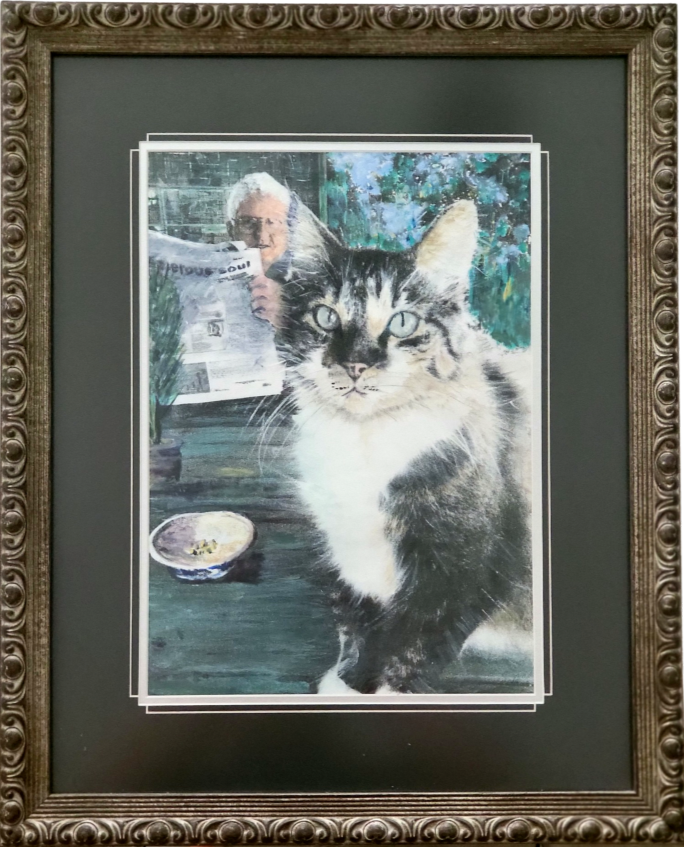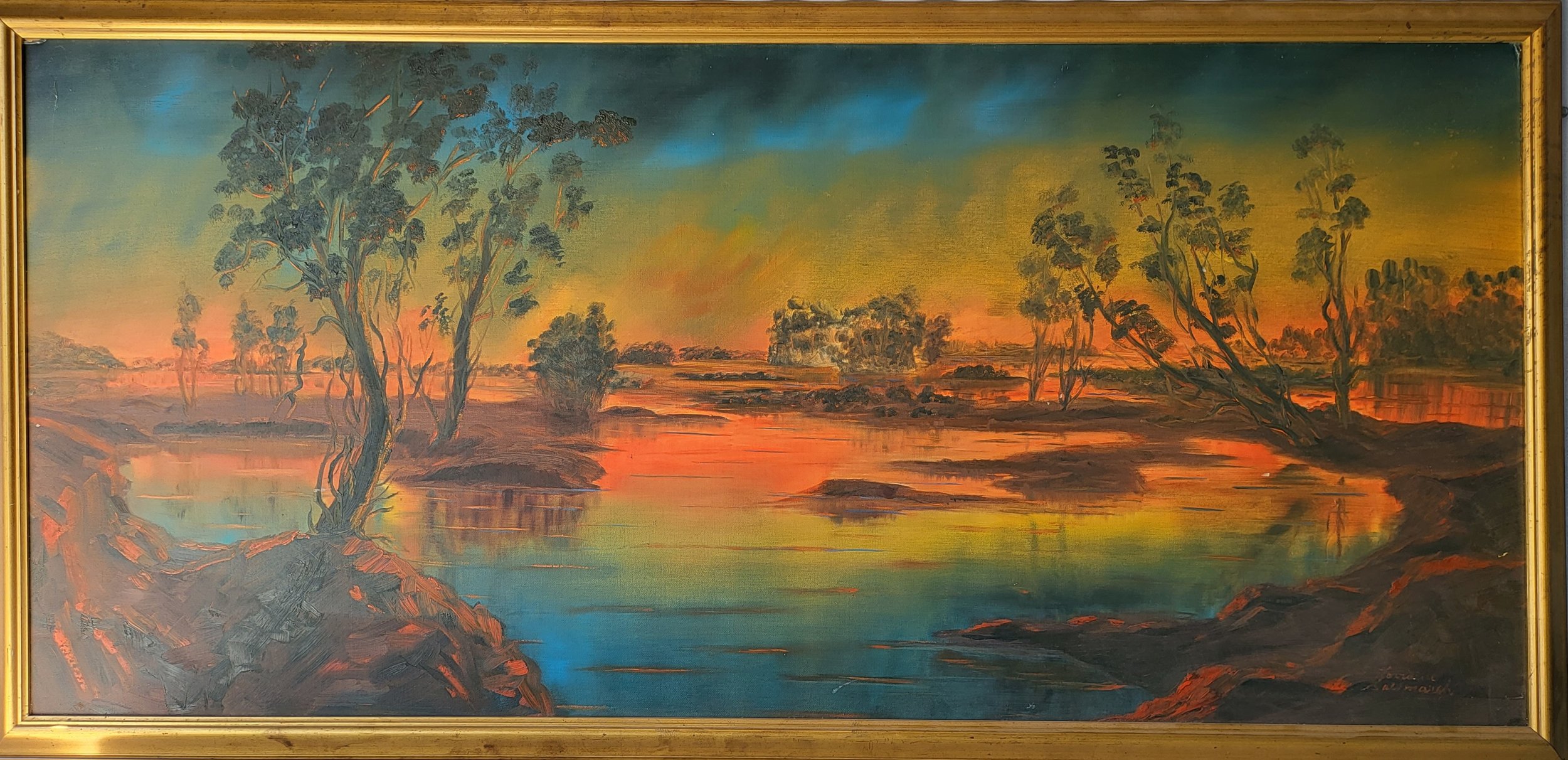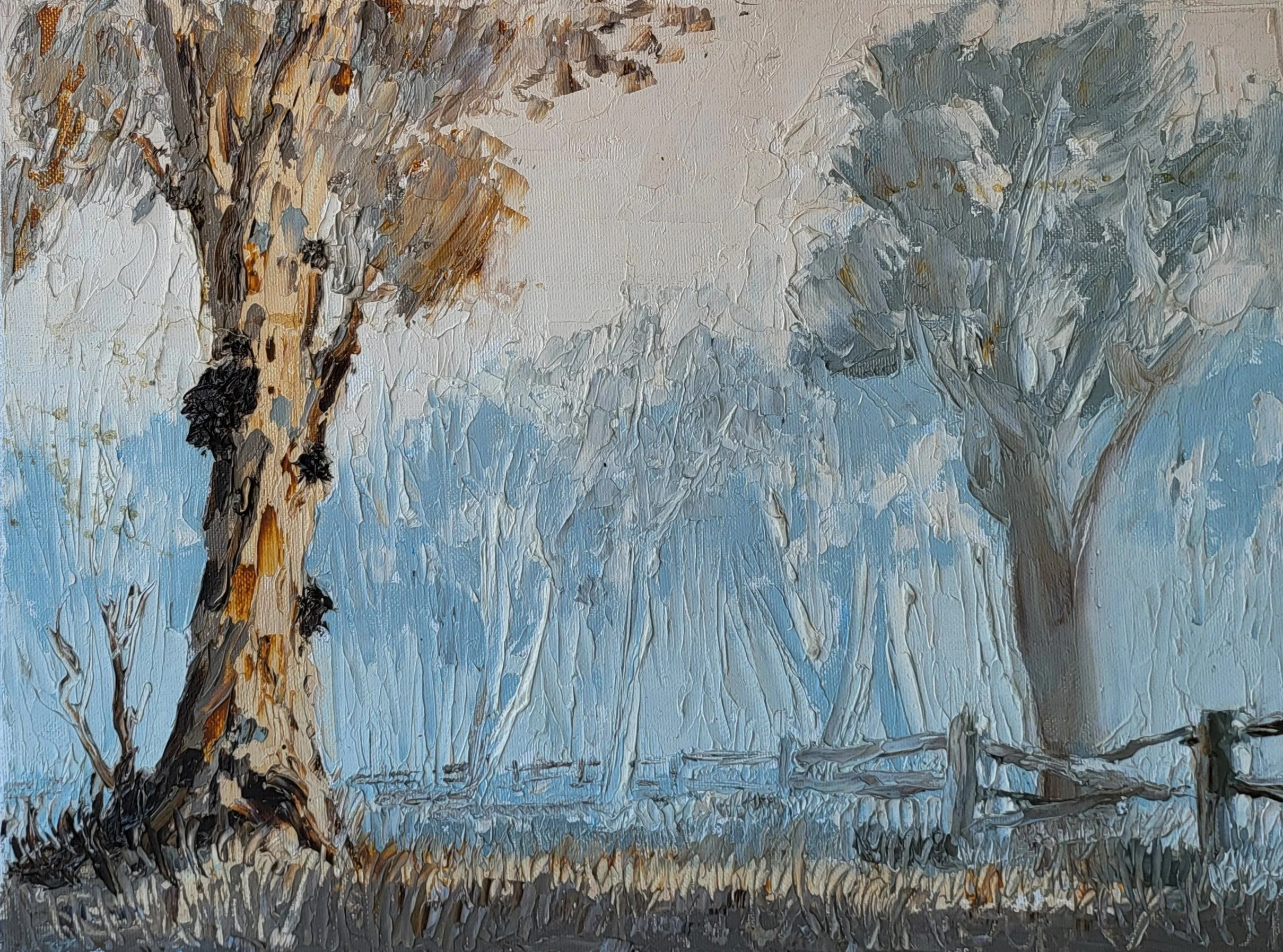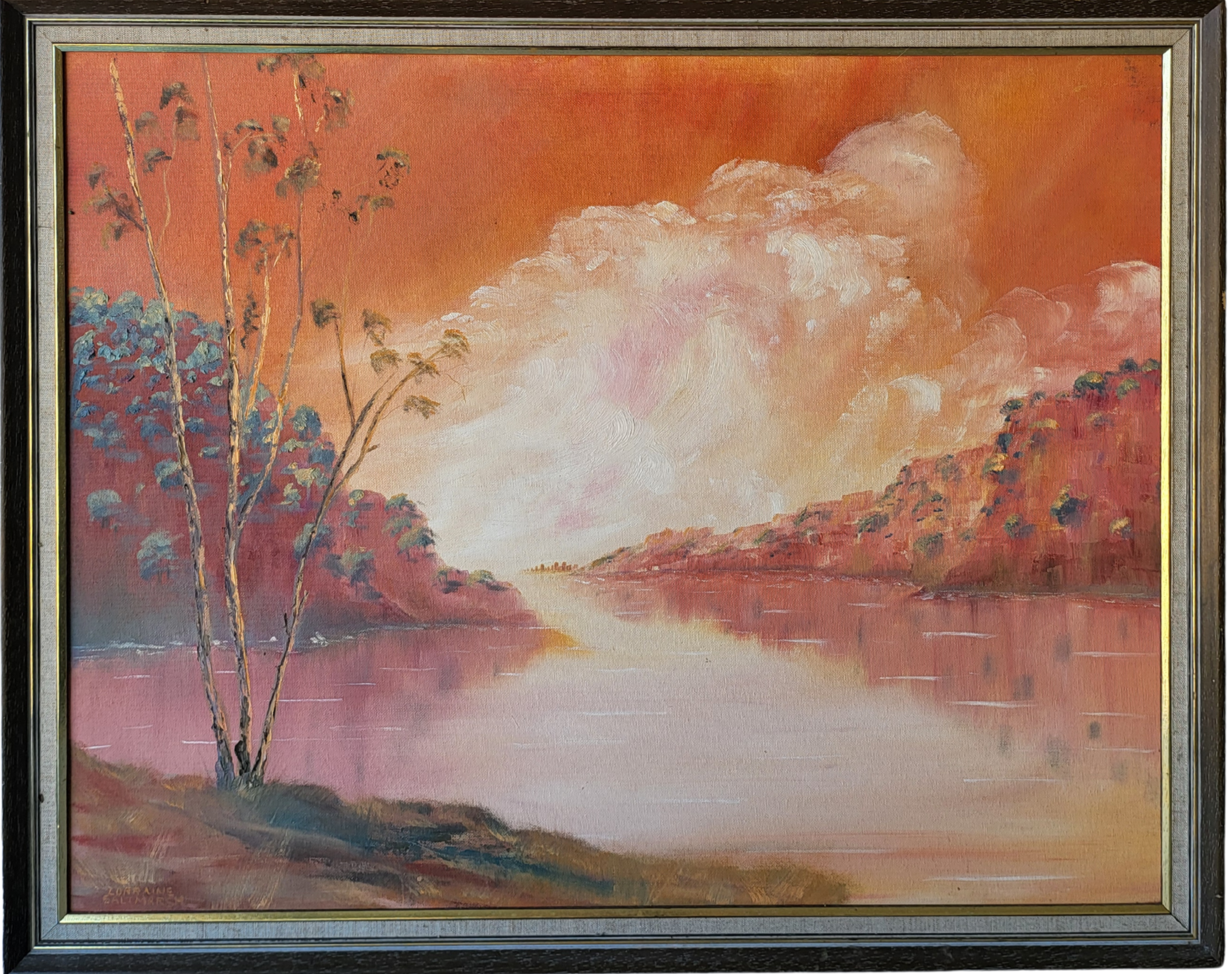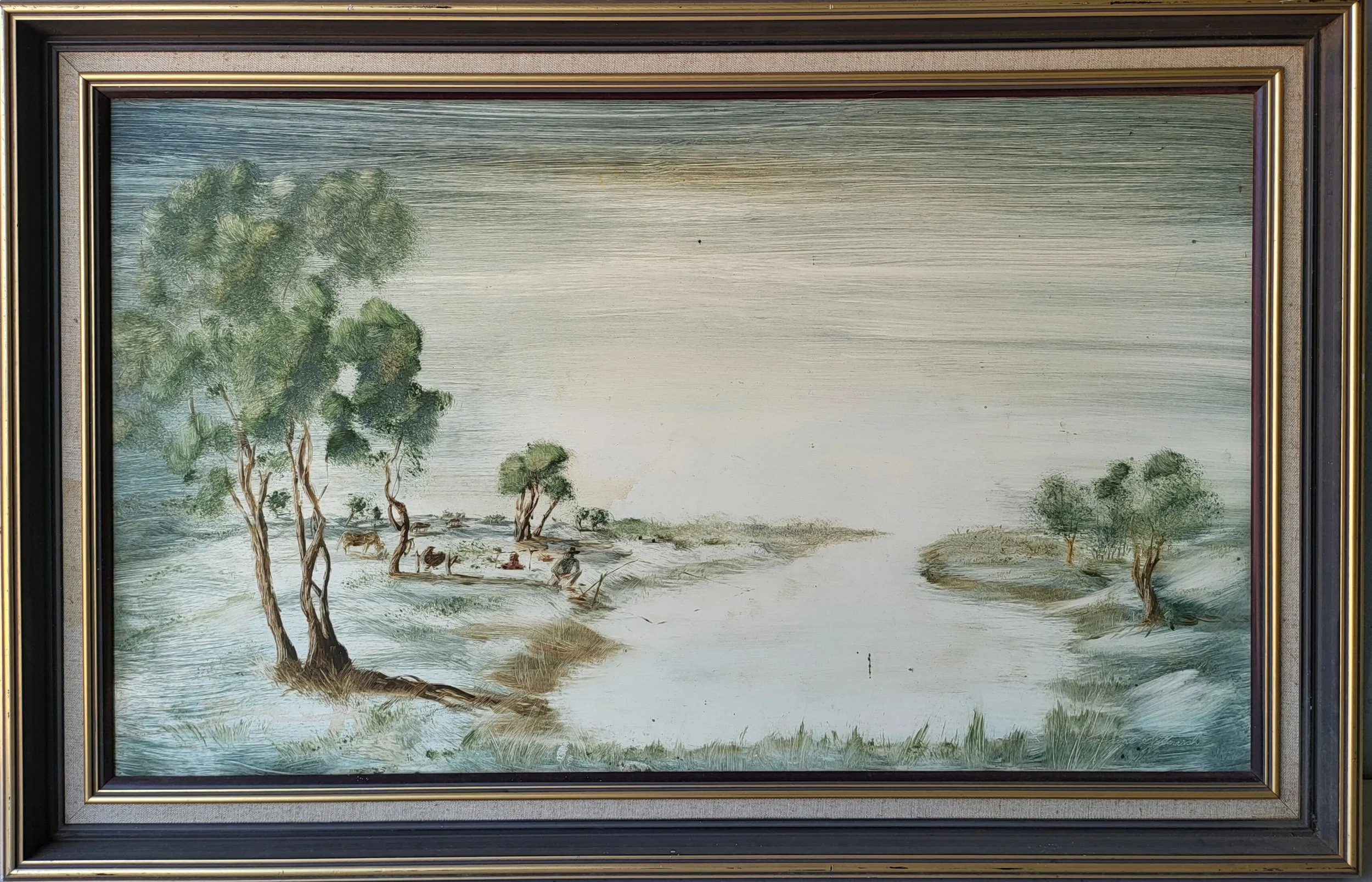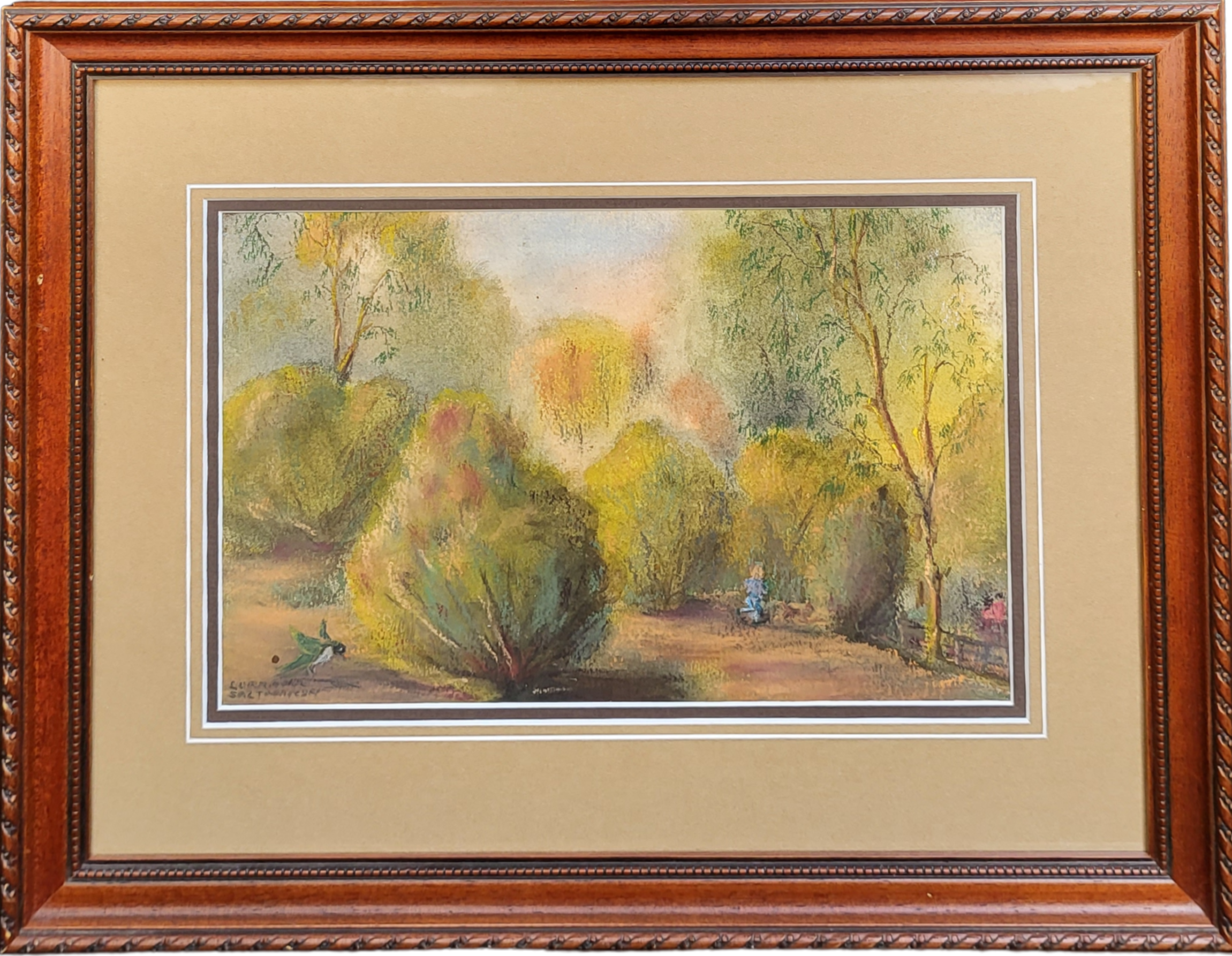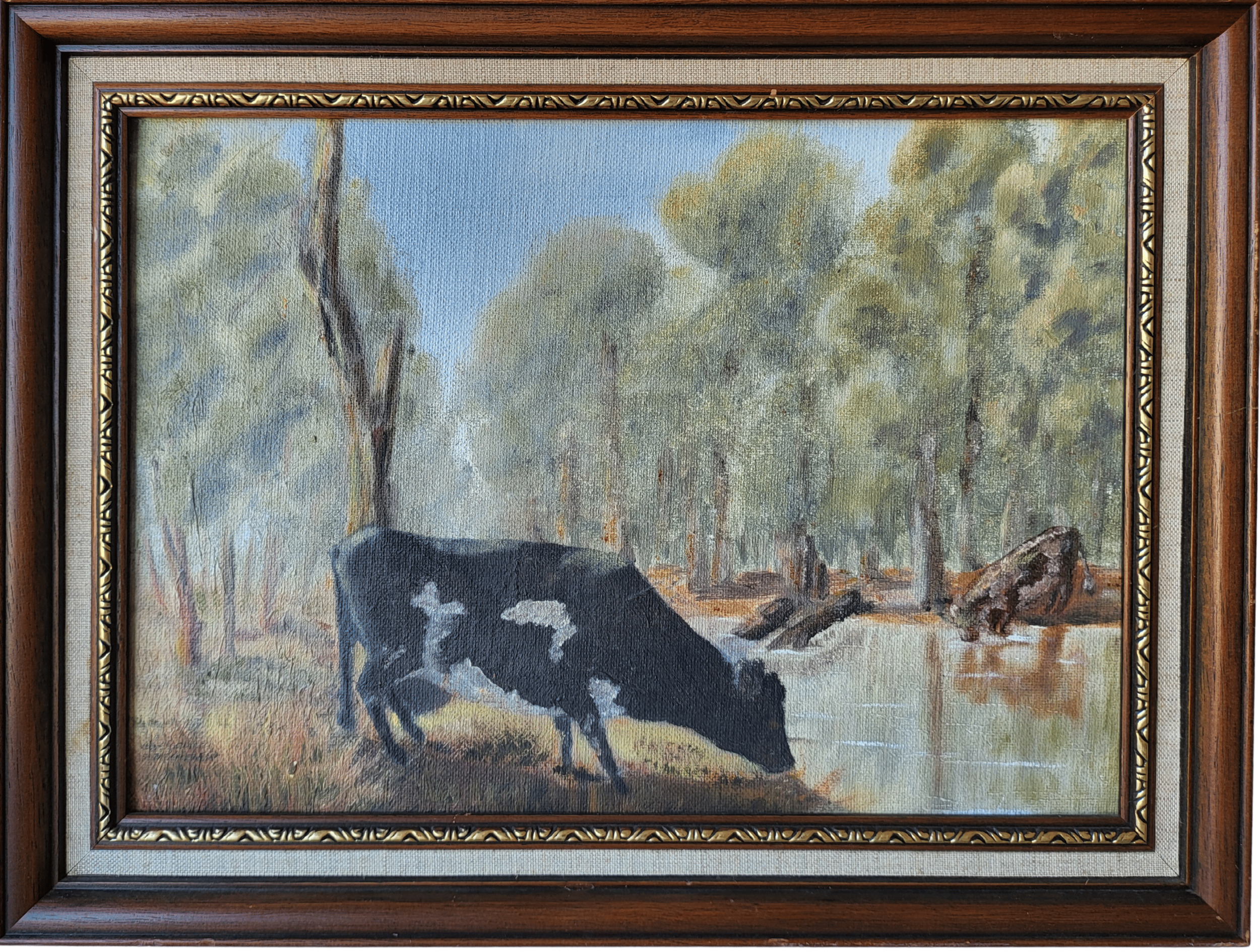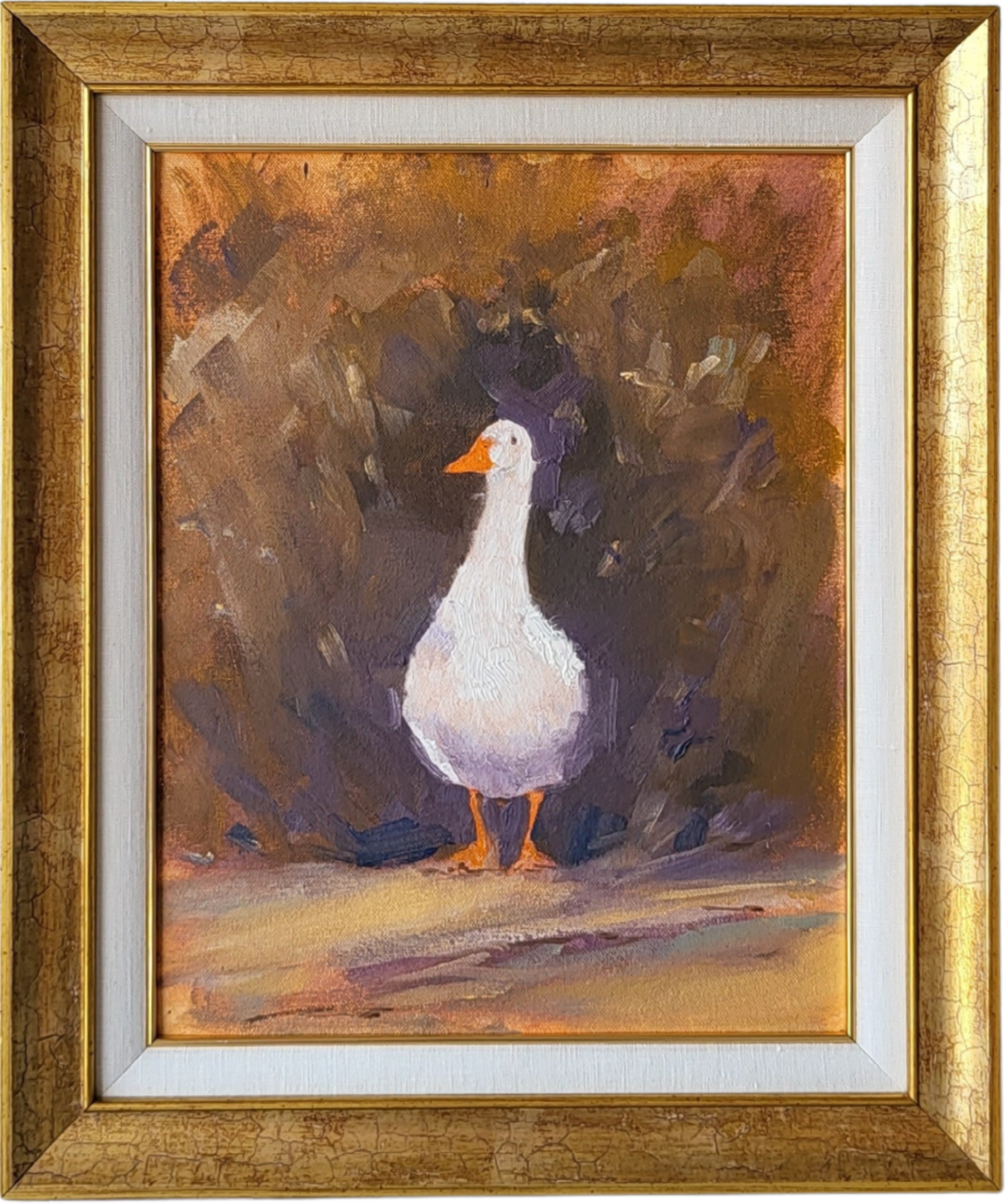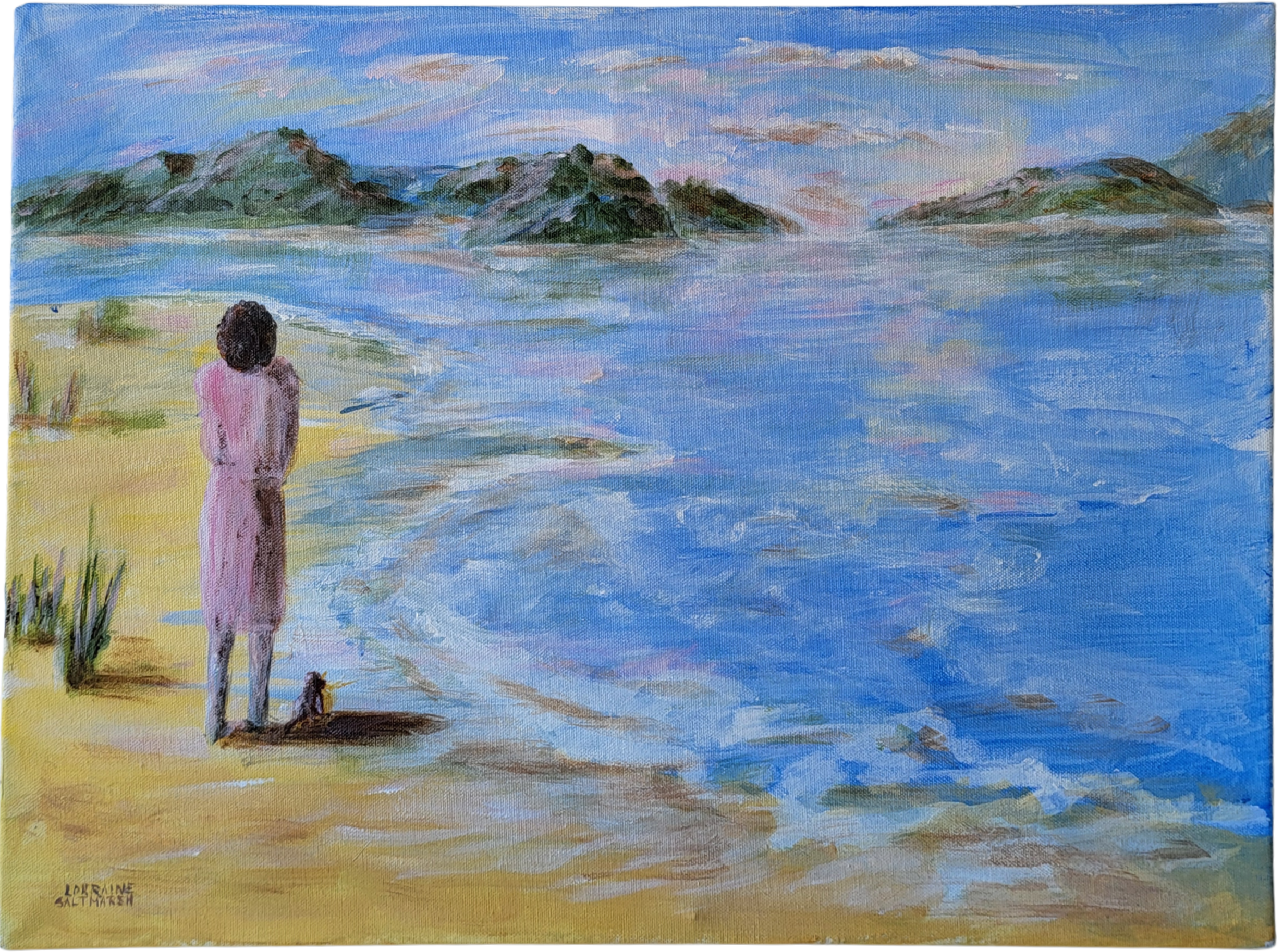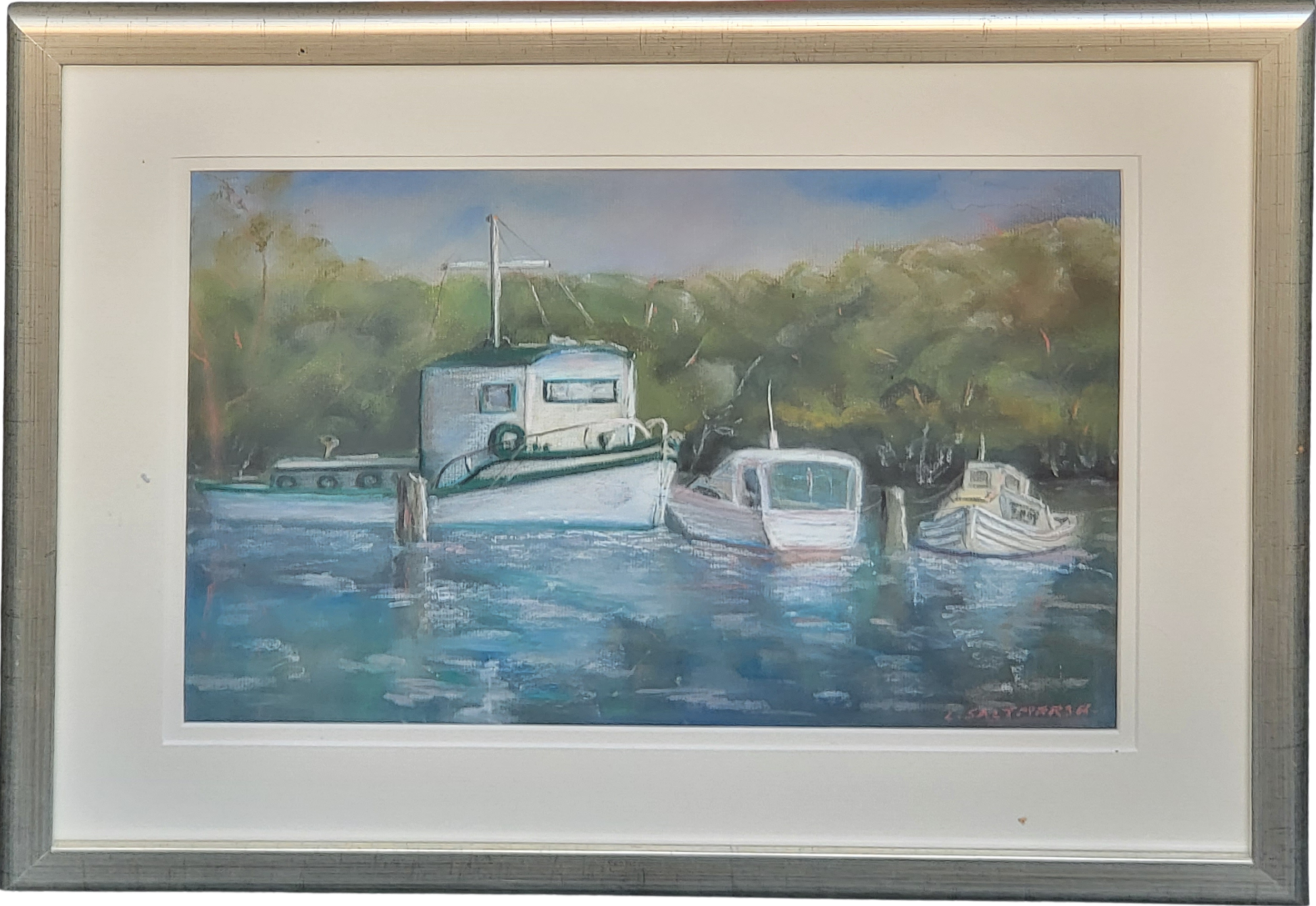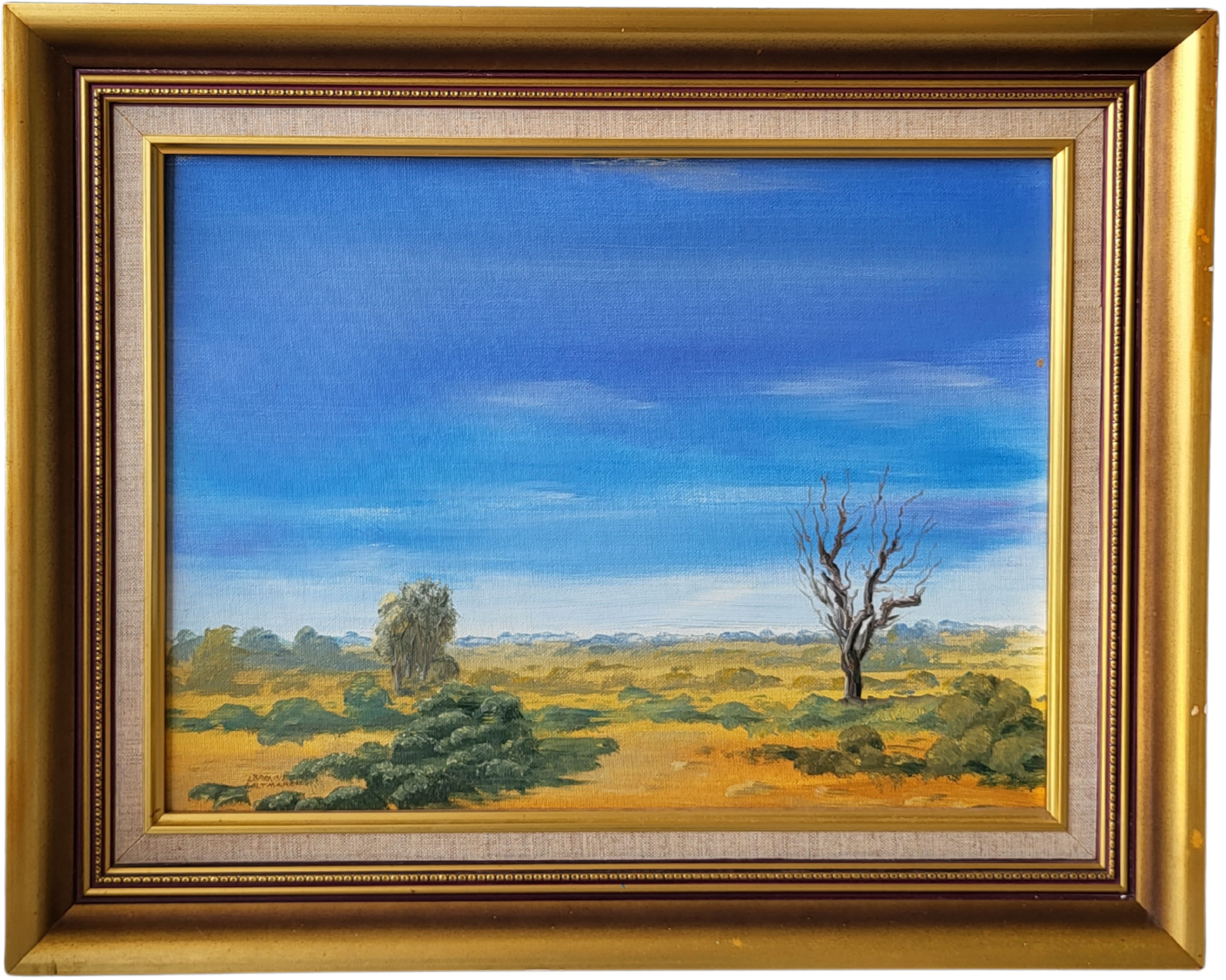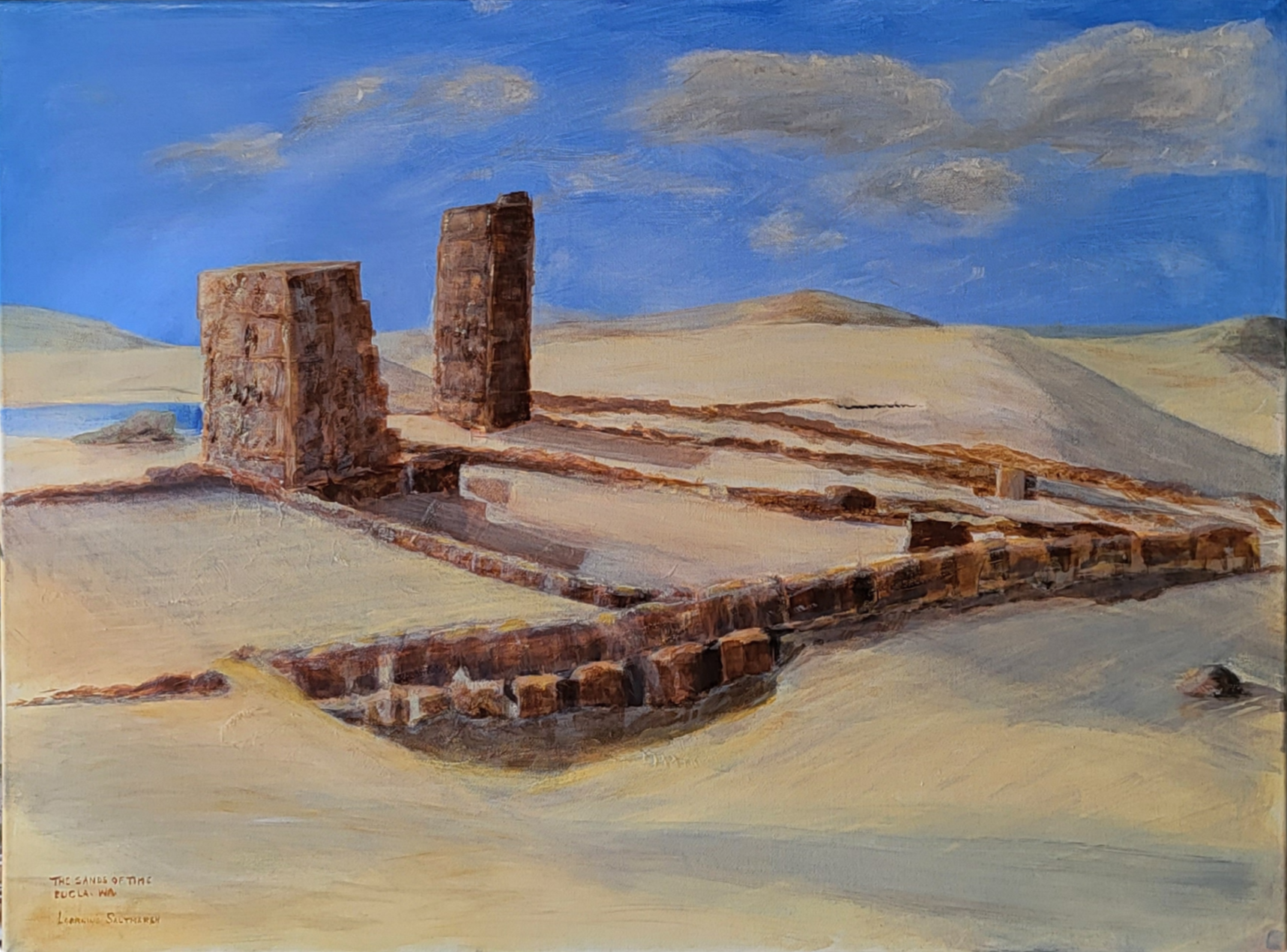Our Story
Inspired by Lorraine
Artwork Above:
Embers Over Water by Lorraine.
Picture Right: Lorraine on her 85th birthday.The Lorraine Foundation was born from a deep admiration for the life and legacy of Lorraine Saltmarsh, a remarkable artist and compassionate soul who brought joy and creativity to countless Australian communities.
Lorraine’s life is a testament to the transformative power of play, laughter, music, art, and imagination. Through her work and countless community initiatives, she nurtured a love of creativity and inspired generations to embrace the beauty of self-expression.
Lorraine believes that every child deserves the chance to dream, explore, and heal through creativity, no matter their circumstances. Her unwavering commitment to helping others, coupled with her passion for the arts, has shaped the mission of The Lorraine Foundation.
Today, we carry forward Lorraine’s vision by bringing the joy of art and reading to disadvantaged children and those experiencing crisis or trauma. We understand how vital these experiences are for building resilience, fostering emotional well-being, and helping children regain a sense of normalcy and hope.
Through our programs, we honour Lorraine’s legacy, ensuring that her love for imagination and creativity continues to brighten young lives across Australia.
A Note on
Lorraine’s Legacy
Over an artistic career spanning nearly 78 years, Lorraine created a remarkable body of work that touched communities across Australia. Many of her finest paintings were sold during her lifetime and, as was common in the era, no copies or official records were kept.
Her art, however, continues to live on. Lorraine’s works can still be found adorning the walls of local pubs and restaurants throughout regional New South Wales and Victoria, hanging in community art galleries, and treasured in dozens of private collections.
This gallery represents only a small window into her lifelong dedication to creativity and storytelling. It stands as a tribute to the lasting impression she has left on Australian art and the communities she loves.
📩 Do you own a piece of Lorraine Saltmarsh’s work?
If you have one of Lorraine’s artworks or know where one is displayed, we’d love to hear from you. Sharing images or stories will help us preserve her legacy and build a more complete archive of her artistic journey for future generations.
-
Pencil and Watercolour
This intimate work captures her husband, Max, during a quiet summer afternoon in their backyard. Originally sketched in pencil and finished with delicate watercolours, the piece reflects the importance and warmth of domestic life.
In the foreground, the family’s cat (Motor) gazes directly outward, its presence commanding, yet affectionate. Behind, Max is depicted reading the newspaper beneath the shade of gumtrees, while the background suggests the lively chorus of birds that so often visited the couple’s home.
The composition blends realism with Lorraine’s characteristic gentleness, celebrating the simple, enduring moments of love, companionship, and connection to nature that defined their life together.
More than a portrait, the piece is an ode to Max’s generous, stoic nature — a man of his time who passed away only two years later. It reflects the deep love and enduring partnership Lorraine and Max shared, and stands as a tender record of a life well-lived together.
-
Pen and Pencil
Sketched in pen and later shaded with grey lead, this piece is one of Lorraine Saltmarsh’s many quick studies of Australian wildlife. Created around 2001, it depicts two koalas resting in the branches of a gumtree on Ulupna Island, a place Lorraine returned to often for inspiration.
Lorraine visited Ulupna both in her own time and during intercultural exchange tours, where she introduced visiting students to the hidden beauty and quiet wildlife of the Riverina. Though simple in execution, the drawing captures the gentle presence of the animals in their natural environment and reflects Lorraine’s lifelong love for sharing the Australian landscape with others.
-
Acrylic on paper
This vivid piece captures a parent magpie returning to its nest with food for its chicks. The scene is full of life; the young birds cry out with open beaks while their parent balances on the woven twigs of the nest, set against a backdrop of Riverina sky and gum leaves.
Created during the 1990s, the work reflects Lorraine Saltmarsh’s close observation of Australian birdlife and her talent for bringing everyday encounters with nature into focus. The choice of subject (a familiar and iconic Australian bird) echoes her deep connection to the landscapes of regional New South Wales and Victoria, where she lived and worked.
The painting remains untitled in Lorraine’s records, but it has here been named Magpies on the Foreshore to honour its setting and subject.
This artwork is believed to have been completed on the foreshore of Tocumwal NSW.
-
Watercolour on Paper
This vibrant study of a Blue-faced Honeyeater shows Lorraine’s enduring appreciation of Australian birdlife. Painted during the 1980s, the work captures the striking plumage and distinctive facial markings of the bird, perched attentively on a gum branch, feeding from native blossoms nearby.
While a small amount of reflection and glare is visible in the framed image, the clarity of Lorraine’s technique still shines through. Her careful layering of watercolours conveys both the fine detail of feathers and the soft washes of the natural background, reflecting her gift for blending precision with atmosphere.
The Honeyeater remains one of Lorraine’s best-loved subjects, a reminder of the beauty and character of everyday wildlife in the Riverina landscapes she calls home.
-
Oil on Canvas
Painted during bushfire season, this early landscape by Lorraine Saltmarsh captures the intensity of the Australian environment in a time of crisis. The sky and water are lit in searing hues of orange, red, and gold, while silhouetted gumtrees stand starkly against the fiery glow. The scene conveys both the beauty and the danger of the land, as dusk settles over a river made luminous by smoke and flame.
Created around 1970, the painting reflects Lorraine’s evolving style and her gift for blending emotional depth with landscape form. The dramatic contrasts and bold brushwork offer not only a view of place but also a record of lived experience during one of Australia’s most testing natural seasons.
Lorraine's landscapes capture more than scenery,
they reflect the spirit of the communities who belong to them.
She wove together the beauty of the land with the stories,
rhythms, and resilience of the people who lived alongside it.
Her work stands a testaments to both place and belonging.
-
Oil on Canvas
Painted in the bushland around Yarrawonga VIC during the 1980s, this work showcases Lorraine Saltmarsh’s bold, textural style. Heavy strokes of oil paint are built up into a thick impasto, giving the gumtrees and grasses a striking sense of depth and presence.
The muted blue-grey palette conveys the cool hush of the forest, while the central tree stands tall in warm tones, a quiet anchor in the scene. A rustic split-rail fence winds through the foreground, grounding the composition in rural Australia.
This painting is both a study of form and a tribute to the natural world Lorraine so often turned to for inspiration, evoking the timeless character of the Riverina bush.
-
Oil on Canvas
This painting, likely created in the 1980s, captures Lorraine’s ability to fuse drama and serenity within the Australian landscape. A brilliant sky of molten orange and rose tones fills the canvas, dominating the scene with luminous energy. Billowing white clouds rise above a tranquil river, their soft forms reflected in the still water below.
On the left, delicate gum trees stretch upward, their pale trunks and cool foliage offering contrast to the warmth of the cliffs and sky. The interplay of colour and light creates a sense of both movement and timeless stillness, reflecting Lorraine’s fascination with how the Australian bush transforms under changing skies.
The title Radiant Sky honours the glowing intensity at the heart of this work; a moment where land, water, and atmosphere are united in vivid harmony.
-
Oil on Canvas
This still life was completed by Lorraine Saltmarsh as part of her formal arts degree, demonstrating her technical skill and compositional discipline during her academic training.
The work depicts a tabletop arrangement familiar to any working artist: a reading lamp casting light across paintbrushes, jars, tubes of paint, and a well-worn smock. At its centre is E.H. Gombrich’s The Story of Art, a seminal text for art students worldwide. Lorraine places the book as both subject and statement, acknowledging its influence while asserting her own role in the ongoing story of art.
The crisp rendering, controlled lighting, and careful attention to texture reveal her ability to blend observational accuracy with painterly confidence. Beyond an assignment, this painting stands as a quiet reflection on the artist’s own journey - a moment of study that also celebrates the tools, texts, and rituals of creative life.
-
Oil on Board
This early work by Lorraine Saltmarsh depicts a quiet pastoral scene along a riverbank, where cattle graze and figures tend to the land beneath sparse gum trees. Executed in oils on board, the painting demonstrates her emerging style; balancing delicate brushwork with a soft, atmospheric palette of greens, browns, and muted skies.
The composition is anchored by the gentle curve of the river, which draws the eye into the distance, while the human and animal figures hint at the deep ties between community, livelihood, and the natural environment.
Painted during the 1960s–70s, this work is one of Lorraine’s earlier explorations of rural life, capturing both the physical landscape and the rhythms of community that shaped her career-long devotion to recording the Australian bush.
Wildlife and Observation
Her wildlife sketches (quick studies in pen, pencil, or wash) highlight her gift for observation.
These works are not only artistic but documentary, preserving glimpses of birds, kangaroos, and native flora encountered during travels and intercultural exchanges.
Even in small studies, she conveys personality and vitality.
-
Pastel on Paper
This pastel work captures a soft, almost dreamlike bushland scene where dense, rounded shrubs and slender trees are dappled in warm sunlight. Hues of yellow, green, and amber blend to create a gentle glow, suggesting either late afternoon light or the turning of seasons.
The scene is subtly animated by the inclusion of children moving quietly among the foliage. Their presence invites viewers to consider the intimacy of community life in rural Australia, where human activity and natural environment exist in quiet harmony. A bird in the foreground adds a further touch of liveliness, reinforcing Lorraine’s talent for balancing the stillness of landscape with signs of movement and life.
Saltmarsh’s handling of pastels is delicate yet assured, layering strokes that allow light and texture to intermingle, giving the piece both immediacy and atmosphere.
-
Watercolour on Paper
This delicate watercolour captures the stillness of the Murray River, where red earth meets calm water beneath a clear blue sky. Birds rise from the treeline, while the reflections of gum and foliage ripple faintly across the river’s surface.
Painted circa the 2000s, the work shows Lorraine Saltmarsh’s sensitivity to light and atmosphere in small-scale studies. Unlike her larger oil landscapes, this piece relies on the immediacy of watercolour to convey a fleeting moment - the hush of an afternoon when land and water merge in quiet harmony.
Though modest in size, Untitled (River Reflections) demonstrates Lorraine’s enduring fascination with the Australian landscape, balancing strength of place with an almost meditative calm.
-
This painting depicts an abandoned homestead, its tin roof weathered and outbuildings falling into disrepair.
Lorraine balances nostalgia and reality, evoking the lives once sustained here while honouring the passage of time in the bush.
-
Painted during one of Lorraine and Max’s regional camping trips, this work captures a red-earth track winding toward distant blue ranges.
Anchored by a towering gum tree, it reflects both the grandeur and intimacy of outback travel.
Emotional Resonance
Her art is deeply personal.
From playful works such as Young Ned – Something to Say, where humour and imagination take centre stage, to profoundly moving pieces like Can’t Be Far Away Now, her first painting after her husband Max’s passing,
Lorraine’s art is a diary of resilience, love, and reflection.
-
Oil on Canvas
Painted in the early 1960s, this work reflects Lorraine Saltmarsh’s deep connection to rural life and the working landscapes of Australia painting depicts a black-and-white cow pausing to drink at the edge of Duton Sheepwash Creek, with the surrounding bushland rendered in soft greens and ochres. Fallen logs and still water ground the composition in the quiet rhythms of the station environment.
As one of Lorraine’s earlier works, it carries both documentary and artistic value; capturing not only a pastoral scene but also a way of life closely tied to the land. The gentle treatment of light and atmosphere hints at the style that would later define her career.
-
Oil on Canvas
Painted circa the 1980s, Before the Water Falls is one of Lorraine’s most evocative landscapes. Using oil on canvas with her characteristic layered brushwork, she builds a textured scene that conveys both strength and delicacy.
The painting depicts a rocky plateau where water gathers in a shimmering pool before spilling into the unseen depths below. On one side, tall pine trees rise densely against the soft glow of the distant ranges. The stillness of the water and the pastel tones of the sky create a mood of quiet anticipation, a moment suspended between serenity and motion.
Through her bold use of texture and subtle modulation of colour, Lorraine captures the timeless beauty of the Australian bush, inviting viewers to pause at nature’s edge before the water falls.
-
Acrylic on Canvas
This playful work was created during a collaborative studio art session where several local artists were given the same outline sketch and asked to bring it to life in their own way. Lorraine imagined the figure of “Young Ned” (a goose with attitude) wandering up to her with “something to say” about all this art business.
The painting reveals Lorraine’s humour and imagination, combining bold brushstrokes and lively colour to give Young Ned personality and presence. She later reflected that she “thoroughly enjoyed the activity” and found the goose “very interesting,” adding that the piece simply made her feel happy.
More than a technical exercise, this work is a testament to Lorraine’s joy in the creative process, her willingness to experiment, and her love of bringing stories and characters to life.
-
Oil on Board
The Last Stand is a powerful study of resilience and decline in the Australian bush. At its centre is the stark form of a hollowed and broken gum tree, its jagged silhouette rising defiantly from a sunlit plain.
Though stripped of much of its canopy, the tree remains rooted and commanding - a survivor of fire, storm, and time.
Lorraine balances strength and fragility in this work. The bold, textured rendering of the central trunk contrasts with the softer, hazier trees in the background, evoking both endurance and the passage of generations.
Symbolic as well as naturalistic, The Last Stand is both a portrait of a tree and a meditation on survival.
-
Oil on Canvas
This painting marks Lorraine Saltmarsh’s first artwork following the passing of her husband, Max, in 2013. Titled Can’t Be Far Away Now, it captures the raw grief and enduring love of a widow waiting for her partner; visible on the horizon yet forever out of reach.
In the composition, a solitary figure in a pink dress stands on the shoreline with a small dog at her side, gazing out toward distant headlands. The vast ocean and glowing sky create a sense of both beauty and separation, where closeness is felt but connection remains just beyond grasp.
The work resonates with longing, resilience, and tenderness, embodying Lorraine’s lifelong devotion to Max. It stands as a poignant reminder of love’s persistence beyond loss, and how art can give voice to emotions too deep for words.
Strengths in Landscape
Lorraine’s landscapes demonstrate a remarkable ability to capture the Australian environment not as static scenery, but as living, breathing spaces infused with memory and community.
Works such as Before the Water Falls show her command of atmosphere, moments suspended between stillness and movement, while others capture the resilience of rural life, drought, and renewal.
Lorraine often painted en plein air, imbuing her pieces with immediacy and honesty, yet always balancing technical discipline with lyrical interpretation.
Tone of Community
Perhaps most distinctive is Lorraine’s ability to capture the tone of communities within her landscapes.
The bush, riverbanks, and foreshore scenes she painted carry an undercurrent of the lives and labours connected to those places.
In doing so, she created works that resonate not just visually but socially, reflecting the spirit of the regions she knew so well.
-
Pastel on paper
This serene pastel scene depicts a cluster of small boats moored along a quiet riverbank. The soft layering of colours gives the water its reflective shimmer, while the blurred greens of the treeline capture the stillness of the backdrop.
Pastels allowed Lorraine to explore atmosphere with delicacy, using gentle transitions between light and shade to convey movement in the rippling water. Unlike her bolder oils, this medium lends the work a dreamlike calm, as if the boats rest not only in the river but in memory.
Painted in the 1990s, Moored Boats reflects Lorraine’s fascination with the places where land and water meet - locations that hold both livelihood and leisure, community and solitude.
-
Rust-red soil meets clear blue sky in this study of rural industry. Isolated water tanks and trees punctuate the horizon, embodying the endurance and ingenuity of remote communities.
Painted during one of Lorraine and Max’s remote camping trips.
Stylistic Character
Though not bound to a single school or movement, Lorraine’s art is unified by an authenticity of voice.
Her brushstrokes are often bold, layered with texture, while her watercolours and pastels show sensitivity to light and season.
She was unafraid to let technical imperfection yield to emotional truth, a quality that makes her work both relatable and enduring.
-
Oil on Canvas
This work captures the timeless stillness of the Australian outback. Rolling dunes and warm ochre sands stretch across the canvas, shaped by wind and shadow.
A stone foundations stand sentinel against the fading light, while soft tones of blue and violet in the horizon suggest the close of day.
In Sands of Time, Lorraine reflects on the endurance of the landscape and the quiet passage of time marked in shifting earth and fading skies. It is both a celebration of nature’s grandeur and an acknowledgment of its transience - a reminder of how the land carries stories long before, and long after, us.
-
Oil on Canvas
A vast outback plain stretches beneath a brilliant blue sky. Two lone trees, one living, one bare, stand in quiet contrast, a reminder of both resilience and fragility in the Australian landscape.
Painted during camping trips and regional expeditions with Max and close friends.
Lorraine Saltmarsh should be remembered as an artist who bridged the personal and the communal, the intimate and the vast.
Her works embody the Australian condition: resilient, generous, humorous, and deeply tied to land and loved ones.
Her art stands as both record and relief, a testament to how creativity can speak to grief, belonging, and the quiet dignity of everyday life.


